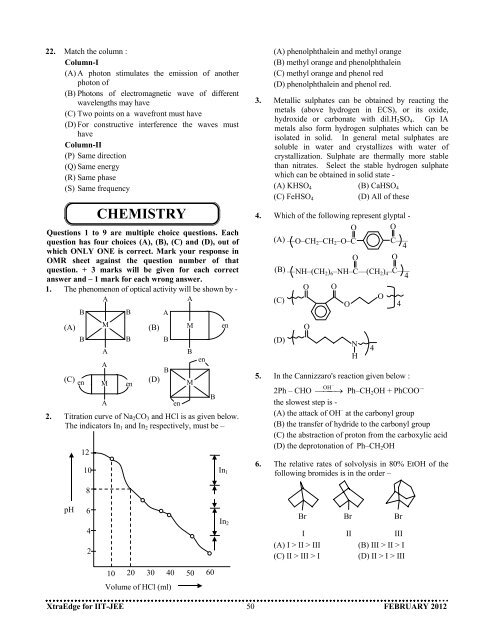1. Xtra Edge February 2012 - Career Point
1. Xtra Edge February 2012 - Career Point
1. Xtra Edge February 2012 - Career Point
Create successful ePaper yourself
Turn your PDF publications into a flip-book with our unique Google optimized e-Paper software.
22. Match the column :<br />
Column-I<br />
(A) A photon stimulates the emission of another<br />
photon of<br />
(B) Photons of electromagnetic wave of different<br />
wavelengths may have<br />
(C) Two points on a wavefront must have<br />
(D) For constructive interference the waves must<br />
have<br />
Column-II<br />
(P) Same direction<br />
(Q) Same energy<br />
(R) Same phase<br />
(S) Same frequency<br />
CHEMISTRY<br />
Questions 1 to 9 are multiple choice questions. Each<br />
question has four choices (A), (B), (C) and (D), out of<br />
which ONLY ONE is correct. Mark your response in<br />
OMR sheet against the question number of that<br />
question. + 3 marks will be given for each correct<br />
answer and – 1 mark for each wrong answer.<br />
<strong>1.</strong> The phenomenon of optical activity will be shown by -<br />
A<br />
A<br />
B<br />
B A<br />
(A)<br />
M<br />
B B<br />
A<br />
A<br />
(C) en M<br />
A<br />
en<br />
(B)<br />
(D)<br />
2. Titration curve of Na2CO3 and HCl is as given below.<br />
The indicators In1 and In2 respectively, must be –<br />
pH<br />
12<br />
10<br />
8<br />
6<br />
4<br />
2<br />
B<br />
B<br />
en<br />
M<br />
B<br />
M<br />
en<br />
10 20 30 40 50 60<br />
Volume of HCl (ml)<br />
B<br />
en<br />
In1<br />
In2<br />
(A) phenolphthalein and methyl orange<br />
(B) methyl orange and phenolphthalein<br />
(C) methyl orange and phenol red<br />
(D) phenolphthalein and phenol red.<br />
3. Metallic sulphates can be obtained by reacting the<br />
metals (above hydrogen in ECS), or its oxide,<br />
hydroxide or carbonate with dil.H2SO4. Gp IA<br />
metals also form hydrogen sulphates which can be<br />
isolated in solid. In general metal sulphates are<br />
soluble in water and crystallizes with water of<br />
crystallization. Sulphate are thermally more stable<br />
than nitrates. Select the stable hydrogen sulphate<br />
which can be obtained in solid state -<br />
(A) KHSO4 (B) CaHSO4<br />
(C) FeHSO4 (D) All of these<br />
4. Which of the following represent glyptal -<br />
O O<br />
(A) ––O–CH2–CH2–O–C C–––<br />
4<br />
O O<br />
(B) ––NH–(CH2)6–NH–C––(CH2)4– C–––<br />
4<br />
O O<br />
(C)<br />
O<br />
O<br />
4<br />
<strong>Xtra</strong><strong>Edge</strong> for IIT-JEE 50 FEBRUARY <strong>2012</strong><br />
(D)<br />
O<br />
N<br />
H<br />
5. In the Cannizzaro's reaction given below :<br />
⎯ –<br />
OH<br />
2Ph – CHO ⎯→ ⎯ Ph–CH2OH + PhCOO –-<br />
the slowest step is -<br />
(A) the attack of OH – at the carbonyl group<br />
(B) the transfer of hydride to the carbonyl group<br />
(C) the abstraction of proton from the carboxylic acid<br />
(D) the deprotonation of Ph–CH2OH<br />
6. The relative rates of solvolysis in 80% EtOH of the<br />
following bromides is in the order –<br />
Br<br />
Br<br />
I<br />
II<br />
III<br />
(A) I > II > III (B) III > II > I<br />
(C) II > III > I (D) II > I > III<br />
4<br />
Br

















